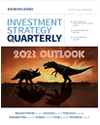by Larry Adam, Chief Strategist, Raymond James
Raymond James CIO Larry Adam reflects on the market and economy’s record-breaking recovery from the depths of the early pandemic.
To read the full article, see the Investment Strategy Quarterly publication linked below.
As we sit atop our prosperous peak, admiring the views of the fastest economic growth since 1984, the best start to a bull market and the record-breaking quarter of earnings growth, it’s wise to remember that not too long ago we began our uphill journey from the depths of the COVID-19 ravine. Often, the best views come after the hardest climbs.
A record amount of fiscal stimulus restrained the unprecedented tumble in economic growth. Now, we’ve headed back to stadiums, theaters, schools and restaurants, moving the economy onward and upward – despite the new variants lurking along the trail. But the days of soaring fiscal aid are ending.
Even as Congress debates over as much as $4.5 trillion of stimulus, a compromise will likely yield half that amount, with the distribution spread over a ten-year period. With excess disposable income already descending ~$1 trillion from its $2 trillion peak, an unavoidable fiscal cliff looms next year.
Fortunately, four factors should cushion the economy from a hard fall:
- Gradually filling the record 10+ million job openings
- Increasing wages
- Rebuilding depleted inventories
- Boosting business capital expenditures
Indeed, the economy should keep climbing at an above-trend economic pace through at least 2022.
The eruption in economic growth over the last year has packed sizable returns in commodities’ backpacks, particularly for oil. Bolstered by OPEC’s supply discipline and the industry’s reluctance to invest more in new drilling, oil prices are currently at three-year highs. Our forecast calls for tempered moves from this point on — prices peaking slightly higher in the first quarter of 2022 before subsiding to the mid $70s by this time next year.
The economy trekking upward at a sustainable pace eases pressure on the Federal Reserve (Fed) to maintain an ultra-accommodative monetary policy. As a result, the Fed’s first step this quarter will be dialing back the emergency-induced bond purchasing program. But until the Fed’s balance sheet plateaus mid next year, we believe there are many miles to go before it tightens policy and raises interest rates (not until 2023).
The expected decrease in Fed bond purchases has many analysts concluding interest rates will spike, but we disagree. The reason: our government will issue significantly less debt next year. As a result of healthy economic growth, the 10-year Treasury yield will scale gradually higher to 1.75% over the next 12 months. However, the upward climb will be limited due to solid demand from foreign buyers, pension funds, and retirees acting as a rappelling force. While low yields can be discouraging, investors should view bonds as a safety harness for their portfolio. Bonds may not seem necessary during the less challenging legs of a journey, but they will be appreciated when the trip gets tough.
The equity bull market keeps ascending to higher altitudes. With a secure macroeconomic backdrop, above-trend earnings growth, rising dividends, and low interest rates, this rally should have endurance. Impressive earnings have been the bedrock, and CEOs are signaling that supply chain shortages, pricing pressures, and labor misalignments will resolve soon. Therefore, our S&P 500 2022 earnings estimate of $225 translates into a 4,950 price target by the end of next year. While our bias is to the upside, the proposed corporate tax hike could result in a 3-5% reduction to our earnings forecast. However, given the history of previous tax increases and the resiliency of corporate America, it should not cause a significant decline at this early stage of the bull market.
While the S&P 500 avoided a 5%+ pullback for over ten months, it did succumb on the last day of the quarter. However, temporary periods of fatigue are normal and given the supportive long-term fundamentals, equities should offer some attractive buying opportunities. U.S. equities remain our preferred territory, as the strong economic recovery and magnitude of earnings growth make it the leader of the pack. Given the recovery’s durability, we favor select cyclicals: the Consumer Discretionary, Financials, Communication Services, Industrials, and Energy sectors.
Wise investors prepare for their financial future – identifying objectives, assessing risk tolerance, protecting against events that could be detrimental to the plan and determining asset allocation parameters that act as a compass for the stated goals. With confidence in your plan and a trusted advisor, we hope you have the guidance and tools needed to accomplish your investment objectives.
Read the full
Investment Strategy Quarterly
Investment Strategy Quarterly is intended to communicate current economic and capital market information along with the informed perspectives of our investment professionals. You may contact your financial advisor to discuss the content of this publication in the context of your own unique circumstances. Published 10/1/2021. All expressions of opinion reflect the judgment the author, the Investment Strategy Committee, or the Chief Investment Office and are subject to change. Past performance may not be indicative of future results. There is no assurance any of the trends mentioned will continue or forecasts will occur. The performance mentioned does not include fees and charges which would reduce an investor’s return. Dividends are not guaranteed and will fluctuate. Investing involves risk including the possible loss of capital. Asset allocation and diversification do not guarantee a profit nor protect against loss. Investing in certain sectors may involve additional risks and may not be appropriate for all investors. The indexes mentioned are unmanaged and an investment cannot be made directly into them. The S&P 500 is an unmanaged index of 500 widely held securities.















